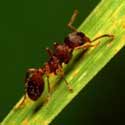Beneficial Nematodes Not Effective for Fire Ant Control
 By: Robert A. Dunn, Department of Entomology and Nematology, University
of Florida - IFAS
By: Robert A. Dunn, Department of Entomology and Nematology, University
of Florida - IFAS
Recent press releases have promoted products based on the insect-parasitic nematode, Steinernema carpocapsae, for control of imported fire ants. This species and related nematodes have been used very successfully to control many kinds of soft-bodied insects such as white grubs (larvae of various scarab beetles), some caterpillars, and the larvae of fungus gnats and other flies. However, they have not proven effective for actually reducing fire ant populations or fire ant colonies in the field.
We are not aware of any credible scientific evidence that documents any nematode species to be efficient for controlling imported fire ant colonies. These nematodes are able to kill individual ants in the laboratory, but in field trials the ant colonies usually respond to nematodes by moving, sometimes splitting colonies in the process.
Among problems in using nematodes to control fire ant colonies are:
- Desiccation of the nematodes before they can penetrate deeply into the mound, especially if they are introduced when soil is hot and are not applied with large amounts of water.
- Application of the nematodes with a large volume of water is likely to disturb the colony enough that it will move and perhaps split.
- Imported fire ants can move much faster and farther than can the nematodes, so ants can easily escape them.
The products that appear to be most effective in eliminating fire ants are those formulated as baits (small amount of pesticide in an attractive food) so the ants pick up the treated particles and carry them into the undisturbed nest. Unfortunately, many bait products are not legally registered for use in gardens. They may be used in adjacent lawns, but cannot be used within gardens that include food crops.
Although beneficial nematodes might be used to get fire ants out of gardens by disturbing them, the same effect can be obtained at no extra cost by pouring hot water onto the mounds or by mechanical disturbance.
Those who decide to apply beneficial nematodes to get fire ants out of their gardens should do so when conditions are most favorable for the largest percentage of the nematodes reaching the largest number of ants. Avoid applications when the soil is hot, to minimize death of nematodes by heat and desiccation, and to catch the greatest number of ants nearer the surface where the nematodes can reach them. Most fire ants are deep below ground during the hottest part of a summer day. Better times to apply the nematodes would be early in the morning or about 12 hours after a rainfall during the summer, or during the cooler weather of other seasons.
At this time, no biological control agent identified by scientists to be effective against imported fire ants is available for sale to the public. However, a fungus found by University of Florida scientists to significantly reduce fire ant populations is now being prepared for commercial use and should be available to consumers sometime in 1998 or 1999. In the meantime, Floridians who wish to reduce fire ant problems will have to continue to rely on the practices and products that have been proven helpful, following label directions carefully to give them the best chance of success.


